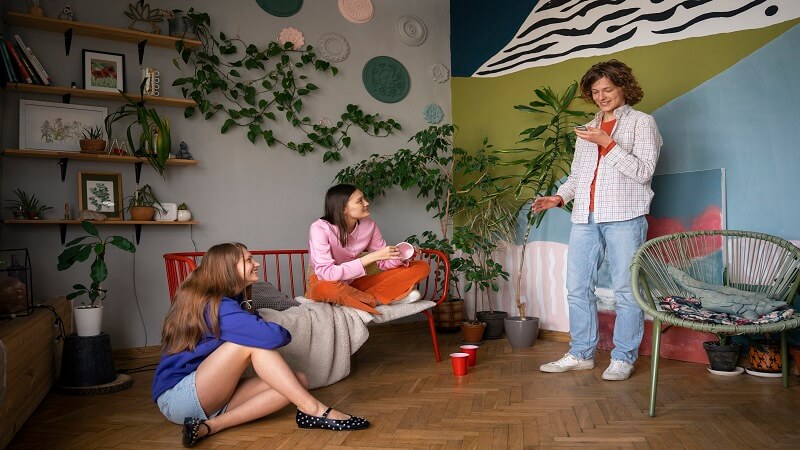Living in a small home can present a variety of challenges, but with the right interior design approach, even the most compact spaces can feel open, functional, and stylish. Whether you’re living in a cozy apartment or a small house, maximizing your space doesn’t mean compromising on aesthetics or comfort. With smart design choices, you can make every square inch count while maintaining a beautiful and organized home.
In this article, we’ll explore creative interior design ideas that will help you make the most out of your small home. From furniture selection to color schemes, these ideas will help transform your small living space into a functional and stylish haven.
1. Embrace Multi-Functional Furniture
One of the best ways to maximize space in small homes is to invest in multi-functional furniture. These versatile pieces serve more than one purpose, making them essential for small spaces.
- Sofa Beds: A sofa bed can be your best friend in a small home. It offers seating during the day and converts into a bed at night, saving you from needing a separate guest room.
- Storage Ottomans: These can be used as footrests, coffee tables, or additional seating. Many also open up to provide hidden storage, perfect for keeping blankets or books out of sight.
- Murphy Beds: These are beds that fold up into the wall when not in use, freeing up floor space for other activities.
2. Use Vertical Space Wisely
When floor space is limited, look up! Vertical space is often underutilized in small homes, but it’s a great way to maximize storage and functionality.
- Wall-Mounted Shelves: Install shelves high on walls to store books, décor, or kitchen supplies without cluttering counters or the floor.
- Tall Furniture: Choose tall storage units like bookshelves and cabinets that extend towards the ceiling. This creates additional storage without occupying much horizontal space.
- Hanging Planters: Rather than placing plants on the floor, opt for hanging planters. This adds greenery to your home while keeping your floor free.
3. Opt for Light and Neutral Colors
Color plays a significant role in how spacious a room feels. Light and neutral colors reflect more light, making a small room feel open and airy.
- White or Soft Pastels: White, cream, and pastel shades can make a room feel brighter and larger. These colors reflect natural light and can make walls appear to recede.
- Monochromatic Color Scheme: Sticking to one color palette, especially in lighter tones, can create a seamless flow throughout the room, minimizing visual clutter.
- Accent Walls: If you’re worried that light colors may feel too bland, consider adding an accent wall in a subtle shade like light grey or soft blue. This will add depth without overwhelming the space.
4. Maximize Natural Light
Natural light is a small home’s best friend. The more natural light you can let into a room, the bigger and more welcoming it will feel.
- Sheer Curtains: Heavy drapes can block natural light. Instead, opt for sheer curtains that let light filter through while still offering some privacy.
- Mirrors: Strategically placed mirrors can reflect natural light and make the room feel more expansive. Hang a large mirror opposite a window to bounce light around the room.
- Open Window Treatments: If privacy isn’t a major concern, consider leaving windows bare or using minimal treatments to allow maximum light into your space.
5. Choose Space-Saving Furniture
In addition to multi-functional pieces, selecting furniture that is specifically designed for small spaces is crucial.
- Folding Tables and Chairs: These are perfect for dining or workspaces that are only used occasionally. When not in use, they can be folded and stored away.
- Nesting Tables: Coffee and side tables that nest under one another are great for providing extra surface area when needed and minimizing space when not in use.
- Slim Furniture: Opt for furniture with a slim profile, like narrow armchairs or sofas with thin arms. These pieces still offer comfort but take up less room.
6. Create Zones in Open-Plan Spaces
In small homes, especially studio apartments, you often have open-plan living areas. While this can make the space feel larger, it can also create a lack of definition between different areas like the living room, dining area, and bedroom.
- Rugs: Use rugs to define different zones within a single room. A rug under the coffee table can mark the living area, while a different one under the dining table can set the dining area apart.
- Room Dividers: A bookshelf, curtain, or folding screen can act as a divider between different parts of the room, providing a sense of separation without the need for walls.
- Lighting: Use different types of lighting in each zone to further distinguish the spaces. For example, a floor lamp in the living area and pendant lights over the dining table.
7. Utilize Under-the-Stairs Space
If your small home has stairs, don’t let the space beneath them go to waste. This is prime real estate for additional storage or even functional areas.
- Built-in Storage: Install drawers or shelves under the stairs to store shoes, coats, or other household items.
- Mini Office: Create a cozy workstation or reading nook under the stairs. Add a small desk, chair, and some shelving for a productive and stylish setup.
- Bookshelves: If you’re an avid reader, under-the-stairs bookshelves are a great way to store your collection without taking up extra space elsewhere.
8. Go Minimal with Décor
Less is more when it comes to decorating small spaces. Too many decorative items can make a room feel cluttered and smaller than it actually is.
- Choose a Few Key Pieces: Rather than filling your space with knick-knacks, opt for a few statement pieces that draw the eye. This could be a bold piece of artwork, a large mirror, or a standout piece of furniture.
- Hidden Storage for Clutter: Keep surfaces like coffee tables and countertops clear by using furniture with hidden storage. Items like remotes, keys, and books can be stashed away to maintain a clean, minimalist look.
- Wall Art: Instead of filling shelves with items, hang artwork on the walls. This keeps floor space free and adds personality to the room without creating visual clutter.
9. Opt for Sliding Doors
Traditional swinging doors take up precious floor space when they open. In small homes, replacing them with sliding doors can free up extra space.
- Barn Doors: These are popular for both bedrooms and bathrooms in small homes. They slide along the wall, eliminating the need for door clearance space.
- Pocket Doors: Pocket doors slide directly into the wall, disappearing when opened and allowing you to use the entire area more efficiently.
10. Keep It Organized
Clutter is the enemy of small spaces. Even the best interior design can be undermined if things are left scattered around.
- Storage Bins and Baskets: Use stylish storage bins and baskets to corral smaller items. Place them on shelves, under coffee tables, or in closets to keep things tidy.
- Closet Organizers: Maximize your closet space with organizers that include hanging shelves, drawers, and shoe racks.
- Declutter Regularly: Make a habit of decluttering regularly. Only keep items that are functional or truly bring you joy. The less clutter you have, the more spacious your home will feel.
11. Make Use of Corners
Corners often go unused, but they’re valuable real estate in a small home. With the right furniture and design choices, corners can become functional areas.
- Corner Shelves: Install corner shelves to display décor or store small items like books, plants, or kitchen supplies.
- Corner Desks: In a small home office, a corner desk can provide plenty of workspace without taking up too much room.
- Corner Sofas: If you have the space, an L-shaped corner sofa can maximize seating while taking up less room than multiple separate pieces of furniture.
12. Mirrors for Depth and Light
Mirrors are a powerful tool in small home design. They can create the illusion of more space by reflecting light and making rooms feel larger.
- Full-Length Mirrors: A full-length mirror placed against a wall or behind a door can open up a small room visually.
- Mirrored Furniture: Consider furniture with mirrored surfaces, like a mirrored coffee table or dresser. This adds a reflective element that enhances the sense of space.
13. Furniture on Legs
Furniture that sits on legs creates an airy, open feeling by allowing more of the floor to be visible.
- Raised Sofas and Chairs: Choose sofas, chairs, and other furniture that sit on legs instead of resting directly on the floor. This helps the room feel less cramped and more spacious.
- Beds with Storage Underneath: A raised bed with storage underneath is a great way to keep your bedroom organized without using extra space for dressers or shelves.
Conclusion
Maximizing space in a small home requires creativity, smart design choices, and a focus on functionality. By embracing multi-functional furniture, utilizing vertical and corner spaces, incorporating light colors, and keeping things organized, you can transform even the smallest of spaces into a comfortable, stylish, and efficient home.
Remember, the key is to think outside the box and prioritize both form and function in every design decision. With these interior design ideas, your small home can feel bigger and more welcoming than ever before.

